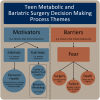Motivators and Barriers to Seeking Metabolic and Bariatric Surgery Among Adolescents: A Qualitative Study
- PMID: 39822948
- PMCID: PMC11736285
- DOI: 10.1002/osp4.70040
Motivators and Barriers to Seeking Metabolic and Bariatric Surgery Among Adolescents: A Qualitative Study
Abstract
Background: The prevalence of severe obesity among adolescents has increased the use of metabolic and bariatric surgery (MBS) as a therapeutic option. Understanding factors influencing adolescent MBS choice and the support needed to undergo MBS is crucial for improving health outcomes. This study examines the motivations and support needs of a diverse sample of adolescents seeking MBS via the patient voice.
Methods: Adolescents (n = 14) at a weight loss surgery clinic in a large academic healthcare system participated in qualitative interviews. Of the participants, 10 were female, 6 were non-Hispanic Black, 3 were non-Hispanic White, and 5 were Hispanic. Interviews were recorded, transcribed, and thematically analyzed.
Results: Three themes emerged: Intrinsic motivators, extrinsic motivators, and barriers. Intrinsic motivators include personal physical and mental health goals. Extrinsic motivators involved family and medical team support, which provided encouragement, validation, and perceived confidence for lifestyle changes. Additionally, observing family members who previously completed MBS was a significant extrinsic motivator. Concerns included fear of dying/complications from MBS, and possible weight regain post-MBS.
Conclusion: Adolescent MBS programs should enhance intrinsic motivation for behavior changes. Findings highlight opportunities for bolstering support pre- and post-MBS and addressing MBS-related anxieties related to long-term weight management.
Keywords: MBS; adolescents; decision‐making; metabolic and bariatric surgery; program support.
© 2025 The Author(s). Obesity Science & Practice published by World Obesity and The Obesity Society and John Wiley & Sons Ltd.
Conflict of interest statement
The authors declare no conflicts of interest.
Figures
Similar articles
-
Psychosocial Factors that Inform the Decision to Have Metabolic and Bariatric Surgery Utilization in Ethnically Diverse Patients.Obes Surg. 2020 Jun;30(6):2233-2242. doi: 10.1007/s11695-020-04454-y. Obes Surg. 2020. PMID: 32060853 Free PMC article.
-
Socioecological factors associated with ethnic disparities in metabolic and bariatric surgery utilization: a qualitative study.Surg Obes Relat Dis. 2020 Jun;16(6):786-795. doi: 10.1016/j.soard.2020.01.031. Epub 2020 Feb 10. Surg Obes Relat Dis. 2020. PMID: 32139155 Free PMC article.
-
Twelve-Month Outcomes after Metabolic and Bariatric Surgery among Youths Participating in a Structured Preparation and Follow-Up Program: Results of the Youth with Extreme Obesity Study.Obes Facts. 2024;17(1):59-71. doi: 10.1159/000535104. Epub 2023 Dec 11. Obes Facts. 2024. PMID: 38081152 Free PMC article.
-
Metabolic and Bariatric Surgery in Adolescents: For Whom, When, and How?Horm Res Paediatr. 2023;96(6):609-619. doi: 10.1159/000524002. Epub 2022 Mar 9. Horm Res Paediatr. 2023. PMID: 35263750 Review.
-
Long-term Outcomes Following Adolescent Metabolic and Bariatric Surgery.J Clin Endocrinol Metab. 2023 Aug 18;108(9):2184-2192. doi: 10.1210/clinem/dgad155. J Clin Endocrinol Metab. 2023. PMID: 36947630 Free PMC article. Review.
References
-
- CDC , “Childhood Obesity Facts. Overweight and Obesity,” Accessed, April 18, 2024, https://www.cdc.gov/obesity/data/childhood.html.
-
- C. D. Fryar , M. D. Carroll , and J. Afful , “Prevalence of Overweight, Obesity, and Severe Obesity Among Children and Adolescents Aged 2–19 Years: United States, 1963–1965 through 2017–2018,” 2020.
-
- Wiggins T., Guidozzi N., Welbourn R., Ahmed A. R., and Markar S. R., “Association of Bariatric Surgery With All‐Cause Mortality and Incidence of Obesity‐Related Disease at a Population Level: A Systematic Review and Meta‐Analysis,” PLoS Medicine 17, no. 7 (July 2020): e1003206, 10.1371/journal.pmed.1003206. - DOI - PMC - PubMed
Grants and funding
LinkOut - more resources
Full Text Sources

